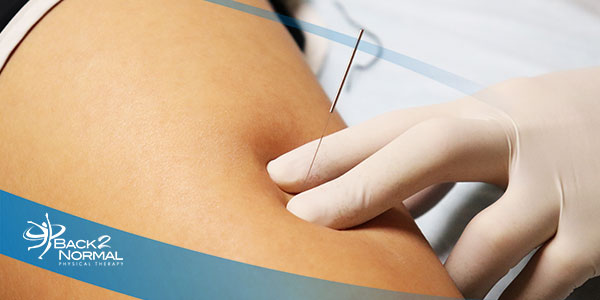
Are you tired of having tight muscles that you can’t seem to get to relax? Have you tried foam rolling and massage and still have some knots in your muscles that are causing you pain and hindering you from everyday life or recreational activities? Dry needling is an excellent treatment option to help resolve your pain!
Dry Needling is especially effective for athletes, allowing for faster recovery and healing to get you Back 2 Normal.
What is a Trigger Point?
Myofascial trigger points, also known as trigger points, are described as hyperirritable spots in the skeletal muscle. They are associated with palpable nodules in taut bands of muscle fibers that can be painful to touch and even refer pain to other areas of the body. Trigger points can cause pain, decrease range of motion and mobility, and inhibit muscles from optimal performance.
But there’s good news: There are many ways you can treat trigger points such as injections, direct pressure with massage techniques, percussion therapy, foam rollers, massage tools, electrical stimulation, heat/ice, and dry needling. And physical therapists have found dry needling one of the most effective ways to relieve pain.
Signs of trigger points:
- Deep, aching pain in a muscle
- Pain that persists or worsens
- A tender knot in a muscle especially to touch
- Muscle tightness that may be shortly relieved with stretching or foam rolling but continues to return.
Causes of trigger points
- Trigger points can form in your muscles after injuries, overuse, or compensation from poor movement patterns.
- Poor posture
- Increased stress or anxiety
- Poor mobility and flexibility
What is Dry Needling and How Does it Work
Dry needling is a technique used by physical therapists to treat trigger points to decrease pain and restore movement restrictions. The technique uses a “dry” needle – a needle without medication or injection – inserted through the skin into areas of the muscle that are tight and causing pain or limiting movement. The needle elicits a local twitch response followed by the relaxation of the muscle. Treatment helps to deactivate the trigger point so the surrounding muscle can relax. This also draws in white blood cells and plasma cells to begin the healing process.
Dry needling is NOT acupuncture, a practice based on traditional Chinese medicine and performed by acupuncturists. Acupuncture targets meridians to help reduce pain amd heal other ailments. Dry needling is a direct treatment to the area of pain and is part of modern Western medicine principles supported by research. Physical therapists who perform dry needling obtain specific postgraduate education and training as well as fulfill requirements outlined by the state in which they practice.
Why Dry Needling?
In cases when physical therapists use dry needling, it is typically a technique that’s part of a larger treatment plan. Physical therapists use dry needling to release or inactivate trigger points to relieve pain, improve range of motion, improve mobility, and improve muscle firing patterns. Preliminary research supports that dry needling improves pain control, reduces muscle tension, and normalizes dysfunctions of the motor end plates; the sites at which nerve impulses are transmitted to muscles.* This can help speed up the your return to active rehabilitation.
Benefits:
- Relief of pain and muscle tightness
- Restores movement and gets you back to living your life
- Researched tested and proven to work
Helps you:
- Target the root cause of your muscle pain so you can achieve long-term relief
- Achieve effective treatment for pain that offers faster recovery from an injury
- Enhance sports performance and recovery
- Eliminate excessive cost
Helps Resolve:
- Musculoskeletal pain
- Muscle stiffness and lack of mobility
- Headaches
- Fibromyalgia and other conditions
Is Dry Needling Painful?
You may feel slight pain of the needle entering the skin, but sometimes it is unnoticeable, depending on the person and the location of the needle. There may be a cramping, aching sensation or slight discomfort that lasts a few seconds. Dry needling may reproduce symptoms directly in the muscle being treated or may refer to other areas of the body. Soreness is normal post-treatment and may last 24-48 hours.
How many sessions are required to see results?
Some patients report 50 percent pain relief after just one session, while others find relief after several sessions.
Learn More
Contact our office with any questions or to set up a FREE 15-minute consult with a Doctor of Physical Therapy to see if dry needling is right for your plan. We are offering $25 off your first dry needling session in August; don’t miss out on this awesome deal!
Contributing Author: Anika Arevalo, PT, DPT, Physical Therapist & Pelvic Health Specialist.
References
Cummings MT, White AR. Needling therapies in the management of myofascial trigger point pain: a systematic review. Arch Phys Med Rehabil. 2001;82(7):986–992. Free Article.
Kalichman L, Vulfsons S. Dry needling in the management musculoskeletal pain. J Am Board Fam Med. 2010;23(5):640–646. Free Article.
apta.org
The Back 2 Normal blog is an educational resource written by Back 2 Normal employees and professional associates. Back 2 Normal bloggers are professionals who abide by the code of ethics outlined by their respective professional associations. The content published in blog posts represents the opinion of the individual author based on their expertise and experience. The content provided in this blog is for informational purposes only, does not constitute medical advice and should not be relied on for making personal health decisions.






